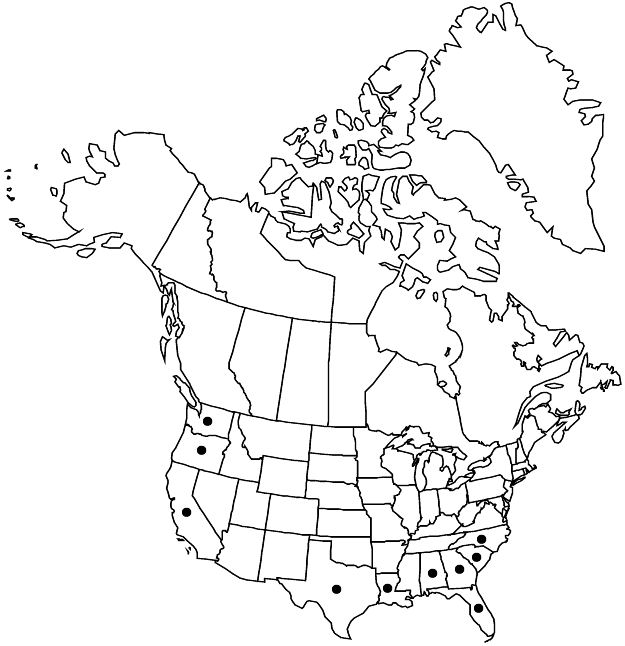Difference between revisions of "Pyracantha fortuneana"
J. Arnold Arbor. 25: 420. 1944.
FNA>Volume Importer |
imported>Volume Importer |
||
| Line 50: | Line 50: | ||
|elevation=0–1500 m | |elevation=0–1500 m | ||
|distribution=Ala.;Calif.;Fla.;Ga.;La.;N.C.;Oreg.;S.C.;Tex.;Wash.;Asia (China);introduced also in Europe (England);Pacific Islands (Hawaii;New Zealand);Australia. | |distribution=Ala.;Calif.;Fla.;Ga.;La.;N.C.;Oreg.;S.C.;Tex.;Wash.;Asia (China);introduced also in Europe (England);Pacific Islands (Hawaii;New Zealand);Australia. | ||
| + | |introduced=true | ||
|discussion=<p><i>Pyracantha fortuneana</i> is native to central and western China. It is variable in the amount of toothing on the leaf blades and color of the hairs on new growth. Plants having grayish hairs on young twigs rather than the usual rusty or brownish hairs have been attributed to the taxon P. rogersiana, which has also been interpreted as a variety of <i>P. crenulata</i>. It is insufficiently distinct to separate from <i>P. fortuneana</i> among the specimens examined.</p> | |discussion=<p><i>Pyracantha fortuneana</i> is native to central and western China. It is variable in the amount of toothing on the leaf blades and color of the hairs on new growth. Plants having grayish hairs on young twigs rather than the usual rusty or brownish hairs have been attributed to the taxon P. rogersiana, which has also been interpreted as a variety of <i>P. crenulata</i>. It is insufficiently distinct to separate from <i>P. fortuneana</i> among the specimens examined.</p> | ||
|tables= | |tables= | ||
| Line 74: | Line 75: | ||
|publication year=1944 | |publication year=1944 | ||
|special status=Introduced | |special status=Introduced | ||
| − | |source xml=https:// | + | |source xml=https://bibilujan@bitbucket.org/aafc-mbb/fna-data-curation.git/src/bb6b7e3a7de7d3b7888a1ad48c7fd8f5c722d8d6/coarse_grained_fna_xml/V9/V9_792.xml |
|subfamily=Rosaceae subfam. Amygdaloideae | |subfamily=Rosaceae subfam. Amygdaloideae | ||
|tribe=Rosaceae tribe Gillenieae | |tribe=Rosaceae tribe Gillenieae | ||
Revision as of 00:33, 28 May 2020
Plants 10–30 dm. Stems: thorns sparse to abundant; young twigs rusty-hairy (gray-hairy in 1 variation), glabrescent. Leaves: stipules 3–8 mm; petiole 2–5 mm; blade oblanceolate or obovate, 1.5–6 × 0.5–2.5 cm, base cuneate, margins remotely serrulate or crenulate, often entire proximally, apex obtuse, emarginate, or short-apiculate, surfaces glabrate. Inflorescences 3–4 cm diam. Pedicels 2–8 mm, usually glabrate, rarely sparsely appressed brown- or gray-hairy. Flowers 4–12 mm diam.; hypanthium glabrate, rarely slightly hairy; sepals triangular, 1–1.5 mm, apex obtuse; petals suborbiculate, 3–4 mm, apex rounded. Pomes orange-red to dark red, 3–6 mm diam.; pedicels 2–10 mm. 2n = 34 (China).
Phenology: Flowering Feb–May; fruiting Sep–Mar.
Habitat: Disturbed ground, roadsides, canyons, woodland edges, open forests, riparian areas
Elevation: 0–1500 m
Distribution

Introduced; Ala., Calif., Fla., Ga., La., N.C., Oreg., S.C., Tex., Wash., Asia (China), introduced also in Europe (England), Pacific Islands (Hawaii, New Zealand), Australia.
Discussion
Pyracantha fortuneana is native to central and western China. It is variable in the amount of toothing on the leaf blades and color of the hairs on new growth. Plants having grayish hairs on young twigs rather than the usual rusty or brownish hairs have been attributed to the taxon P. rogersiana, which has also been interpreted as a variety of P. crenulata. It is insufficiently distinct to separate from P. fortuneana among the specimens examined.
Selected References
None.